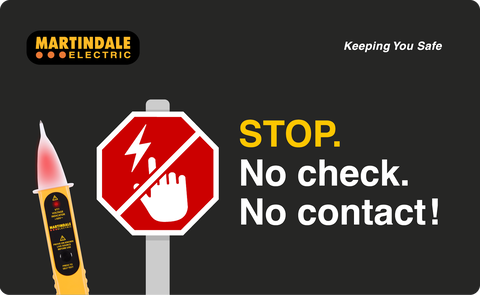Safe isolation is the cornerstone of electrical safety, and it is a rigorous process, but other hazards can still be present when working on electrical systems, warn Martindale Electric.

One such issue is the injuries caused to engineers, contractors, electricians and other workers coming into contact with unexpectedly live metal parts. This includes items such as metal casings on equipment or appliances, pipework, and other types of metalwork which should be earthed. This invisible danger can be present in any workplace situation ranging from simple domestic systems through to commercial and industrial installations.
Martindale, leaders in safe isolation testing, are running a new awareness campaign ‘STOP. No Check. No Contact!’ reminding anyone working on or near electricity not to take any chances with exposed metal parts and to always check first, as they may be live.
“Standard industry-wide safe isolation procedures safely disconnect the supply from the circuit to allow safe rework, maintenance, or installation to take place,” says Steve Dunning, Managing Director at Martindale Electric.
“They do not cover checking for live metal parts though, so incorporating this discipline into established work processes will further minimise risk and help ensure safer working practices. Remember, if the metalwork is not checked for being live don’t touch it: Stop. No check. No contact!”
One potential cause of danger, being widely discussed, is the Protective Earth Neutral or PEN fault. This is where a break or ‘open circuit’ occurs in a PEN conductor, which serves as both the neutral and protective earth. A broken or faulty PEN conductor can cause dangerous voltages to appear on metalwork, creating an electric shock risk and equipment damage. For example, electric vehicle chargers connected to PME networks must have PEN fault protection devices to detect this condition and automatically disconnect the power to prevent electric shock.
For potentially live metallic items, performing a touch test is essential. Single pole contact indicators, such as the Martindale VT7, can be incorporated into touch test safety procedures, however, this class of tester should be thoroughly checked to be functional before each use. Correct use should also be included in relevant safety training.
Other types of tester are used in these situations such as Non-contact voltage devices, but extreme caution must be taken. These devices require a battery in order to work and are often sensitive to other signals, such as static electricity and they cannot reliably be used to prove dead.
By linking the STOP. No Check. No Contact! - message to the many safe isolation products and activities from Martindale the focus is on building awareness around this important safety issue.
For the latest electrical safety information and downloads visit: https://martindale-electric.co.uk/safe-isolation-7/

